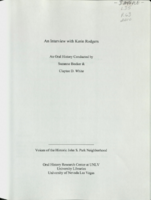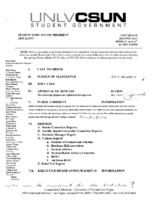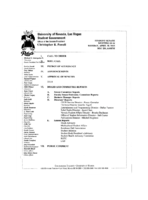Search the Special Collections and Archives Portal
Search Results

Transcript of interview with Kerin Scianna Rodgers by Suzanne Becker and Claytee D. White, February 7, 2009 and August 11 & 16, 2011
Date
Archival Collection
Description
Kerin Rodgers was born in 1936. She recounts her family history and stories of her youth growing up in Boston, MA, and shares how the family relocated to Seattle, WA in the mid-1940s. She talks about her enjoyment of theatrical arts and politics, and about being a resourceful divorced, single-mom and entrepreneur. In 1958 she opened a retail fashion store and modeling agency with a friend in Santa Monica, CA. Kerin had a knack for fashion and interior design that would assist her then and into the future. She also shares the story of arriving in Las Vegas as part of retail job with The Broadway stores in 1966—a two-week stint that seemed to have no ending. Her transition into Las Vegas included remarriage, a 1974 Keno win that enabled her to put down money on a home ( a house built by Paul Huffey) in the John S. Park neighborhood, and making close friends in the community. Her interview is sprinkled with tales of activities and personalities from the neighborhood's past and present. Kerin was involved with the Focus Youth House, speaks about First Fridays and art, as well as gives a perspective of police, criminal behaviors and changes in the neighborhood over the years. She hosted a local television show and enjoyed being a community activist.
Text

Interview with Helen Marguerite (Troester) Draper, June 24, 2004
Date
Archival Collection
Description
Text

Interview with John S. Coogan, May 1, 2008
Date
Archival Collection
Description
Text

Meeting minutes for Consolidated Student Senate, University of Nevada, Las Vegas, April 21, 2008
Date
Archival Collection
Description
Text

Alpha Kappa Alpha Sorority regional officer candidate brochures
Date
Archival Collection
Description
From the Alpha Kappa Alpha Sorority, Incorporated, Theta Theta Omega Chapter Records (MS-01014) -- Chapter records file.
Text

Meeting minutes for Consolidated Student Senate, University of Nevada, Las Vegas, April 28, 2003
Date
Archival Collection
Description
Text

Alpha Kappa Alpha Sorority Inter-Mountain Cluster conference fliers
Date
Archival Collection
Description
From the Alpha Kappa Alpha Sorority, Incorporated, Theta Theta Omega Chapter Records (MS-01014) -- Chapter records file.
Text

Poker Palace Neon Survey document, August 23, 2017
Date
Archival Collection
Description
Site address: 2757 N Las Vegas Blvd
Sign owner: Marvin and Laura Coleman
Sign details: This location opened 1974 with a castle theme. This location is also claimed as a locals casino. In 2015 their main pylon roadside sign caught on fire, but it was recently replaced.
Sign condition: 4- the signs that were not in the fire are still in relatively good condition
Sign form: Two pylons and architectural sign
Sign-specific description: The building itself has many different neon signs on it mostly red neon. Also the buildings architecture matches the palace theme. There are two pylon signs the first one states "Poker Palace Bingo" in channeled neon letters, then below is a reader board. The second pylon is just north a little of the first one, this is the one that caught on fire in 2015. After the fire the beam bases of the sign remained. This sign has "Poker Palace Casino" in red channeled letters.
Sign - type of display: Neon and incandescent
Sign - media: Steel and plastic
Sign - non-neon treatments: Reader board
Sign animation: Flasher for incandescent light bulbs.
Sign environment: This is located in North Las Vegas in a residential area and by a few other small businesses.
Sign - date of installation: Late 2015/ early 2016 for new pylon sign, others look to be older
Sign - date of redesign/move: 2015 pylon sign went up in flames and was destroyed, then replaced
Sign - thematic influences: The building looks like a palace which goes with their names and theme. Also their signs showcases similar shapes to the building.
Survey - research locations: Poker Palace website http://pokerpalace.net/History.html , Images of sign , Review Journal article https://www.reviewjournal.com/local/local-las-vegas/nlv-casino-marquee-fire-sends-up-plume-visible-for-miles/
Surveyor: Wyatt Currie-Diamond
Survey - date completed: 2017-08-23
Sign keywords: Architectural; Neon; Incandescent; Steel; Plastic; Flashing; Reader board; Pylon; Fascia
Text

Meeting minutes for Consolidated Student Senate University of Nevada, Las Vegas, February 7, 1991
Date
Archival Collection
Description
Text

Transcript of interview with Dr. John Shepherd by Lisa Gioia-Acres, November 21, 2008
Date
Archival Collection
Description
Dr. John Richard Shepherd shares the background of his early life in southern Illinois, his father's and grandfather's occupations, and his educational journey through college and medical school. His army experiences in Chicago and Alabama convinced him and his wife to look for a warm dry climate in which to live, and they relocated to Las Vegas in 1968. Dr. Shepherd recalls the businesses and housing surrounding Sunrise Hospital, the difficulties getting his specialty listed in the phone book, and renting his first office space from Nate Adelson. He also describes taking out a loan to install ophthalmology equipment, hiring an office manager with medical accounting experience, and doing cataract surgery in a way that basically hadn't changed for decades. The passing of the Medicare bill back in 1966 caused Dr. Shepherd's practice to build up quickly. He details the many ways eye surgery changed, including the invention of the intraocular lens and the phacoemulsification procedure. He mentions his and Dr. Shearing's contributions to ophthalmology — better designed lenses and surgical techniques - which they taught to other doctors from all over the country. Dr. Shepherd discusses radial keratotomy, which was a precursor to laser and later LASIK surgery, and describes a lens implant technique he learned in Russia from Dr. Fyodorov. He goes on to share anecdotes and stories of his interactions with patients, his travels as a consultant and as a surgical teacher for Project Orbis, and meeting Fidel Castro. He speaks candidly about his successes and his failures as well. Dr. Shepherd retired in 2006 and immediately enrolled in a Master's program and earned a degree in military history. After a long and distinguished career, after receiving many accolades and awards, he and his wife are enjoying life, splitting their time between Sun Valley, Idaho, and Las Vegas.
Text
